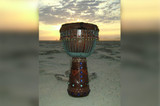How to Play Bongos
Bongos are one of the most well-known drums in the world. The sounds and rhythms of bongos can be heard in all types and genres of music, bringing a Latin flair and the ability to improvise into rock, pop, country, jazz and many other musical selections. Learning to play the bongos can be a fun and exciting time for the new or experienced drummer looking to incorporate the unique sounds produced by these drums.
Bongos are typically played while sitting, although during performances, it is not uncommon to see bongos sitting on a stand. Holding the bongos while sitting requires a drummer's thighs or upper legs to cradle the drums with light pressure, being sure to allow for comfort and flexibility. When seating the bongos, the macho, or smaller of the drums, should be on the player's left while the hembra, the bigger drum, should sit to the right. Left-handed, unconventional or otherwise creative drummers can reverse the drums or find different positions that cater to their own unique style and needs.
Bongoceros, or bongo drummers, use four basic strokes to play their drums: open tone, slap, heel-tip and muted. These strokes require little more than the correct placement of the palms and fingertips on the head of the drum, and a little practice. Always be sure to use the pads of the fingertips when striking the bongos to produce the best sound.
Open tone: Drummers use the part of the palm where the fingers join the hand to strike the edge while the fingertips bounce off the head of the drum. The sound should be clear and crisp, without overtones or other interference.
Slap: With fingers cupped, strike the head of the drum and then relax the fingers so they bounce. The slap sound should sound more like a "pop" than an open tone.
Heel-tip: While resting on the head of the drum, rock the hand from heel to fingertips, keeping the hand on the drum head during the entire motion.
Muted: Using the same motion as the open tone, keep the heel of the palm on the drum to produce the "fingertip" sound only.
After mastering these basic tones, a Bongocero can move onto different sounds and techniques, including snapping the wrist to produce crisper tones or muting the drum head by using other fingers to hold down the center of the drum head.
Once the sounds start to fall into place, its time to introduce basic bongo rhythms. The most common bongo rhythm is the martillo, or hammer, that resembles the trotting sound of a horse. It is played in 4/4 time and can easily be adapted and improvised to suit the style of the drummer or music it accompanies.
For the beginning Bongocero, or even the experienced drummer wishing to add more sounds and instruments to a repertoire, the bongos are easy and fun as well as versatile. The sounds and rhythms of the bongos are quickly learned, making it a favorite among professional and hobbyist percussionists world wide.
Recent Posts
-
What is the Best Size Djembe for Beginners?
If you're new to the world of percussion and interested in learning the djembe, you're in for a t …16th Jul 2024 -
The Benefits of Becoming a Drumming Teacher: Transforming Passion into Profession
Why become a drumming teacher? Becoming a drumming teacher is an excellent way to share your pas …22nd May 2024 -
What Makes the Djembe Drum a Spiritual Instrument in African Music?
Origin and history of the Djembe drum The Djembe drum originates from West Africa and holds sign …16th May 2024



